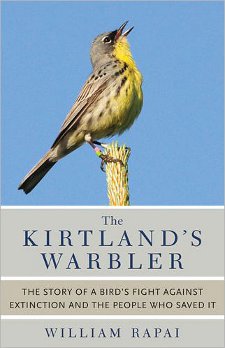Reviewed by Grant McCreary on May 11th, 2012.
I’ve been at least vaguely aware of the Kirtland’s Warbler for almost as long as I can remember. As a kid, I was very interested in endangered animals, particularly birds. So it’s not surprising that the Kirtland’s, one of the rarest birds in North America, would have caught my attention. But I can’t remember knowing anything about the bird, other than that I’d likely never see one. Unhappily, I still haven’t seen a Kirtland’s. But I know much more about them now that I’ve read The Kirtland’s Warbler: The Story of a Bird’s Fight Against Extinction and the People Who Saved It.
The Kirtland’s Warbler is an attractive and, by all accounts, tame and endearing bird. It is also very interesting. Or, perhaps “fussy” would be the better description. It is extremely particular in where it will nest, only accepting large stands of jack pine trees of a certain height. Its entire breeding range is maybe a couple hundred square miles in the northern part of Lower Michigan, along with a few birds recently discovered breeding in Wisconsin and Ontario. As you can imagine, this also makes it an exceedingly rare bird, which only adds to its appeal to birders.
As interesting as the bird itself is, the story of its relationship to people, in particular its conservation, is even more fascinating. This is what William Rapai concentrates on in The Kirtland’s Warbler. As he writes in the introduction, “To tell the story of the Kirtland’s warbler is to tell a story of complex relationships between the bird and its environment, the bird and humans, and the bird and the state and federal governments’ complex policies toward it.”
The tale starts in 1851 with the first specimen collected. But it would be another 50 years until the Kirtland’s breeding grounds were discovered in 1903. Just a few years prior, the eminent ornithologist Frank Chapman, based on a specimen found in migration, posited that it bred in the Hudson Bay region. As it turns out, his hypothesis was quite off the mark. But, as Rapai points out, this general ignorance could very well have saved the species from extinction. If the breeding grounds were known, every collector and museum would have wanted a bird, nest, and/or egg specimen for their collection. In those days, a bird’s rarity did not engender restraint when it came to collecting. Quite the contrary, it only increased the appeal. Such collecting undoubtedly contributed to the extinction of other species, and could easily have been what pushed the Kirtland’s over that precipice.
The narrative really picks up in the early 1970’s with the formation of the Kirtland’s Warbler Recovery Team. This team, comprised of representatives from relevant groups and agencies, was tasked with keeping the bird from becoming extinct. I was surprised to find this story of conservation (salvation, really) and the people behind it to be incredibly interesting. One researcher became an infamous murderer. Later, a tragic, out-of-control prescribed burn took one life and destroyed much property, but also may have saved the warbler from extinction, or at the very least gave it a much-needed population boost.
The effort made to save this bird has been extraordinary. Thankfully, it has not been in vain. When I was reading about the Kirtland’s Warbler as a child, the prognosis was grim. But now, the latest survey (2011) recorded a record high of 1,828 singing males. However, as Rapai points out, the future of the warbler is still not certain. He describes the current and potential future threats to the bird and discusses the ongoing research. There just doesn’t seem to be any getting around the fact that in our human-altered world, extreme habitat specialists such as the Kirtland’s Warbler will likely always be dependent on conservation . But if there’s one thing that Rapai’s account makes clear, it’s that they’re in good hands.
Reading this book, as I did, so soon after Cerulean Blues makes comparing the two unavoidable. Both are well-written books about a threatened warbler. But that’s where the similarities end. The clue to their differences lies in the author and their approach. Cerulean Blues is very personal and informal; you learn almost as much about the author as you do the bird. This shouldn’t be a surprise, as personal is right there in the book’s subtitle. The writing, coming from an English professor, was extremely engaging and fun to read. As a former reporter, Rapai focuses strictly on the story; the author does not appear in the work. Although not as engaging on an emotional level as a personal story would be, it is still well-structured and well-told. Throughout this review, I’ve commented on how interesting the Kirtland’s Warbler and its history are. Much of that is inherent in the subject, especially for birders, but a great deal of it can be credited to the author.
Recommendation
As a kid, I don’t think anyone would have given me good odds that I’d still be able to see a Kirtland’s Warbler in 25 years. But today, the warblers are still hanging on and I fully intend on seeing one. And when I do, it will be thanks to the work done by all of those detailed in this book. Despite the odds, The Kirtland’s Warbler tells a happy story. It’s worth reading by anyone interested in this bird or, especially, conservation.
 This review is a part of Warbler Week – a celebration of warblers in print and other media.
This review is a part of Warbler Week – a celebration of warblers in print and other media.
Disclosure: I get a small commission for purchases made through links in this post.
Disclosure: The item reviewed here was a complementary review copy provided by the publisher. But the opinion expressed here is my own, it has not been influenced in any way.





Comment